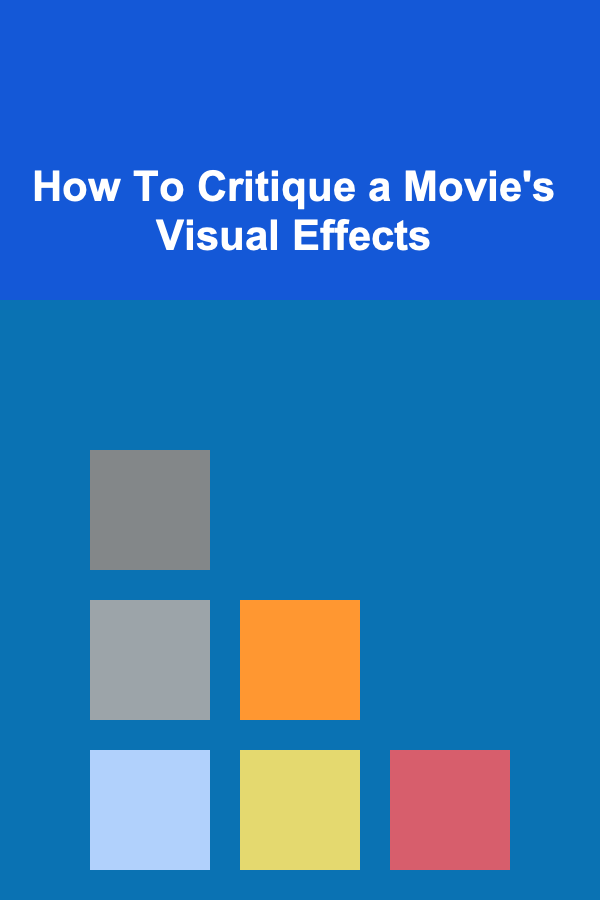
How To Critique a Movie's Visual Effects
ebook include PDF & Audio bundle (Micro Guide)
$12.99$5.99
Limited Time Offer! Order within the next:

When we watch a movie, the first things we often notice are the plot, the characters, and the performances. However, there is another critical aspect of filmmaking that can make or break a movie: visual effects (VFX). Visual effects have become an essential part of modern filmmaking, and with technological advancements, the expectations surrounding their quality have risen dramatically. While it may seem straightforward to judge the visual appeal of a film, critiquing visual effects requires a deeper understanding of the artistry, technology, and impact they have on the overall film.
In this article, we will explore how to critique a movie's visual effects effectively, providing a comprehensive guide to evaluating their quality, their integration with the narrative, and their overall contribution to the cinematic experience. This critique will not only cover the technical aspects of VFX but also the artistic and storytelling components that make them an integral part of the filmmaking process.
Understanding Visual Effects in Film
Before diving into the critique, it is important to understand what visual effects are and their role in film. Visual effects encompass the various techniques and technologies used to create imagery that would be difficult or impossible to achieve through traditional cinematography. VFX are typically used to enhance or alter the reality presented on screen, whether it be creating otherworldly creatures, fantastical environments, or complex action sequences.
In general, visual effects can be divided into several categories:
- Computer-Generated Imagery (CGI): This refers to the creation of visual content using computer software. CGI is often used for creating characters, creatures, or environments that do not exist in the real world.
- Practical Effects: These effects are achieved using physical materials and techniques, such as prosthetics, animatronics, and miniature models.
- Compositing: The process of combining multiple layers of images or footage to create a final shot. This often involves blending CGI elements with live-action footage seamlessly.
- Matte Painting: A technique where painted or digitally created backgrounds are inserted into shots to create expansive or fantastical settings.
Visual effects are not only used in science fiction or fantasy films but also in many genres, such as action, drama, and even historical films, to enhance storytelling or improve visual impact. Understanding this broad scope is key to evaluating the role VFX plays in a film.
Key Criteria for Critiquing Visual Effects
When critiquing visual effects, several key criteria must be considered. These criteria will help determine whether the VFX enhance the storytelling, are technically proficient, and contribute to the overall viewing experience. The following are the essential aspects to assess when analyzing a film's visual effects:
2.1. Realism and Integration with Live Action
The most basic measure of the quality of visual effects is their ability to blend seamlessly with live-action footage. Visual effects are often criticized when they are obviously noticeable or appear "fake." This issue is particularly evident when CGI characters or elements seem out of place in the physical world they inhabit.
- Realism: Does the visual effect look realistic within the context of the film? Does the CGI character, environment, or element interact with its surroundings in a believable way?
- Integration: How well do the visual effects integrate with the live-action footage? Are the lighting, shadows, and textures consistent with the real-world elements? Does the effect move naturally with the live-action footage, such as characters interacting with the environment or other characters?
A good visual effect should complement the live-action shots rather than stand out as something separate. In modern filmmaking, achieving this level of realism has become a standard, and it requires significant attention to detail, advanced technology, and skilled artistry.
2.2. Artistic Creativity and Innovation
While realism is important, visual effects also have an artistic and creative dimension. The imagination behind the VFX can elevate a film, pushing the boundaries of what's possible or bringing fantastical worlds to life. In some cases, the visual effects are not meant to be realistic but rather to create something visually stunning or conceptually abstract.
- Creativity: Does the visual effect bring a unique artistic vision to the film? Is it bold, imaginative, or innovative in its approach? How does it enhance the overall aesthetic of the film?
- Originality: Is the visual effect fresh and distinct from other films, or does it feel derivative or repetitive? Has the film employed techniques in a new or unconventional way?
Creativity in visual effects can be one of the most exciting aspects of modern filmmaking. Movies like Avatar , Inception , and Doctor Strange push the limits of creativity, offering an experience that combines stunning visuals with innovative storytelling.
2.3. Emotional Impact and Storytelling
Visual effects are not just about spectacle---they should serve the story. In a well-made film, the visual effects work in harmony with the narrative to evoke emotions, enhance the storytelling, and deepen the viewer's connection to the characters and world.
- Storytelling: Do the visual effects serve the narrative? Do they reinforce the themes, setting, or tone of the film? For example, in a superhero film, the visual effects may help portray the hero's powers or create epic battles that heighten the emotional stakes.
- Emotional Impact: Do the effects evoke a strong emotional response? A well-executed visual effect should evoke feelings of awe, wonder, fear, excitement, or sadness, depending on the context of the scene.
The best visual effects are those that elevate the story without overwhelming it. In films like The Lord of the Rings trilogy, visual effects not only enhance the fantasy world but also deepen the emotional resonance of key moments, such as the struggle of the characters or the scale of the conflict.
2.4. Consistency and Cohesion
Visual effects should maintain consistency throughout the film. A film with inconsistent VFX can pull the audience out of the experience, creating moments where the audience notices the artifice of the effects rather than becoming immersed in the world. For instance, if a film uses a mixture of practical effects and CGI, there must be a cohesive look across all scenes.
- Consistency: Are the visual effects consistent in quality throughout the film? Do they maintain the same level of detail and realism in each scene?
- Cohesion: Do the visual effects feel cohesive within the broader visual language of the film? Do they match the tone, style, and overall aesthetic established by the cinematography, set design, and costumes?
Films that effectively maintain visual consistency in their effects enhance the sense of immersion and make the viewer less likely to notice the special effects, allowing the story and characters to take center stage.
2.5. Technical Execution and Precision
Technical proficiency is crucial in visual effects. Even the most creative VFX ideas can fall flat if they are not executed with technical precision. This includes everything from the accuracy of the physics simulations to the quality of the texture mapping, lighting, and rendering.
- Detail and Precision: How detailed are the visual effects? Are the textures and models well-crafted, and do they reflect realistic behavior and movement?
- Complexity: How complex are the visual effects? Are they able to portray complex interactions, like the way light interacts with a surface, or the way characters move through a space?
- Render Quality: Is the render quality high? Are there noticeable flaws, such as pixelation, aliasing, or low-resolution textures?
A technical critique should take into account how the visual effects measure up to industry standards. Films with high-quality VFX demonstrate an advanced understanding of technology and artistry, with no visible flaws that distract from the viewing experience.
Examples of Exceptional and Flawed Visual Effects
One of the best ways to understand how to critique visual effects is to look at examples from films that have both succeeded and failed in their use of VFX.
3.1. Successful Examples of Visual Effects
- Avatar (2009) : James Cameron's Avatar revolutionized the use of 3D and CGI, creating a visually stunning alien world that felt alive and immersive. The use of CGI to create the Na'vi characters and their environment blended seamlessly with live-action footage, and the level of detail in the textures, lighting, and character animation was groundbreaking at the time.
- The Matrix (1999) : The visual effects in The Matrix are famous for their innovative use of "bullet time" photography, where the camera moves in slow motion while the characters remain at normal speed. This was a groundbreaking technique that has since become iconic in action films. The effects were not only visually stunning but also served to enhance the film's themes of reality and perception.
- Interstellar (2014) : Christopher Nolan's Interstellar featured some of the most realistic space visuals ever seen on screen, particularly in the depiction of black holes and the visualization of wormholes. The film combined practical effects with CGI to create a sense of realism and awe that perfectly complemented the film's scientific themes.
3.2. Examples of Flawed Visual Effects
- The Mummy Returns (2001) : One of the most frequently criticized films for its use of visual effects is The Mummy Returns, particularly the CGI depiction of the Scorpion King. The character is so poorly rendered that it takes the audience out of the movie, with its unrealistic movements and visible texture flaws.
- The Polar Express (2004) : While groundbreaking for its time, the motion-capture animation in The Polar Express has been criticized for its "uncanny valley" effect, where the characters' facial expressions and movements feel unnatural and creepy. This resulted in a disconnect between the audience and the characters.
Conclusion
Critiquing a movie's visual effects is more than just evaluating whether they look good or not. It involves examining how the effects serve the story, how well they are integrated with live-action footage, and how they reflect creativity, technical skill, and emotional impact. A successful VFX sequence not only enhances the visual appeal of a film but also deepens the audience's connection to the narrative and characters.
By evaluating VFX based on realism, artistic creativity, storytelling, consistency, and technical execution, you can form a comprehensive and nuanced critique of a film's visual effects. Whether a visual effects sequence is groundbreaking or falls short of expectations, it plays an essential role in shaping the cinematic experience and elevating the art of filmmaking.

How to Create a Functional Entryway with Storage for Shoes and Bags
Read More
How to Sell Digital Products Successfully For App Developers
Read More
How to Update Your Home's Look with Minimalist Decor on a Budget
Read More
How to Use Clear Storage Containers for Easy Access and Visibility
Read More
How to Use Lighting to Highlight Artwork and Decor
Read More
How to Mosaic on Furniture: A Step-by-Step Guide
Read MoreOther Products

How to Create a Functional Entryway with Storage for Shoes and Bags
Read More
How to Sell Digital Products Successfully For App Developers
Read More
How to Update Your Home's Look with Minimalist Decor on a Budget
Read More
How to Use Clear Storage Containers for Easy Access and Visibility
Read More
How to Use Lighting to Highlight Artwork and Decor
Read More